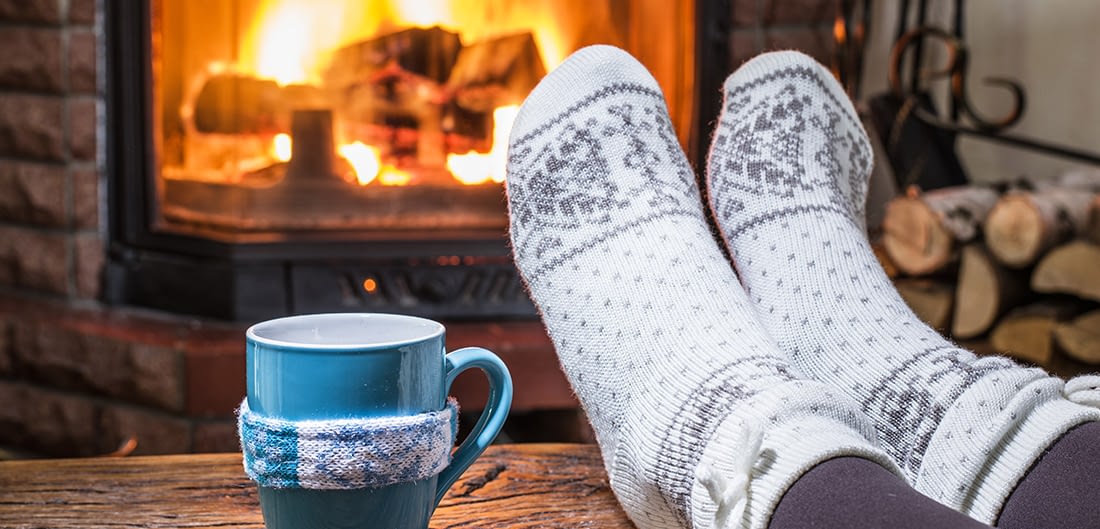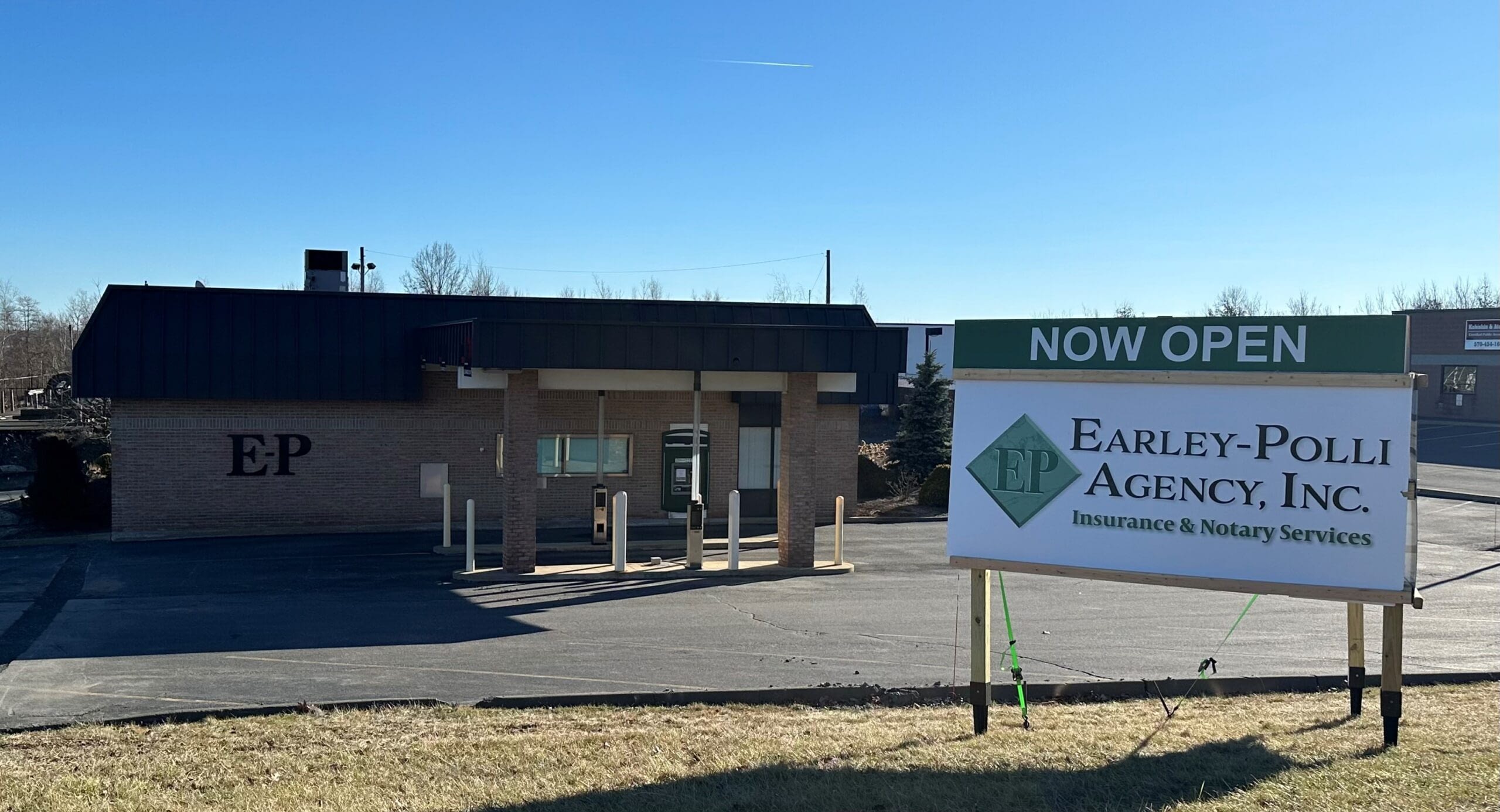It’s an unfortunate fact that space heaters, fireplaces and wood-burning stoves cause more structure fires than central heat and hot-water heaters combined. Between 2009 and 2013, the National Fire Protection Association reported that these heat sources caused 72 percent of home heating fires. And fires caused by space heaters led to 84 percent of deaths caused by home heating fires.
This information isn’t meant to scare you into closing off the fireplace and stashing the space heater. By all means, keep enjoying them—just keep safety in mind so you can protect yourself, your family and your home against smoke and fire damage.
Fireplaces
Few things are as nice as curling up in front of a fireplace that uses real logs in the heart of winter. And if you’ve just spent lots of time in the cold air, the pleasure of basking in a fire’s glowing warmth is somehow quadrupled.
The last thing you want is to interrupt your cozy time with a trip to the emergency room or a call to the fire department. With these tips, you can keep the home fires burning while keeping your home and family safe.
- Before you light the fire, make sure the chimney has some flow. Not taking this step could cause your cozy session to go up in smoke. As you prepare to light the kindling, do this simple test: Open the damper and reach inside the firebox (the place where you light the fire). In the firebox, light and blow out a match. Then, watch where the smoke goes. It should float up and away into the chimney. If it doesn’t, you will want to reach out to a chimney inspector to see if there are any issues.
- Keep the glass door cracked open when the fireplace is in use. Open it just enough to draw air up into the chimney. It should be able to block any sparks from flying out, which can start a fire.
- Consider cracking open a window in your home. It will improve airflow.
- Invest in a fireproof mat and place it in front of the fire. Sparks can still escape when you have to reach in and poke around the fire.
- Establish a 3-foot safety zone around the fireplace. Remind children that running, throwing and horseplay are off-limits.
- Properly dispose of ashes. Even after the embers die away, the ashes can still hold plenty of heat. If you vacuum the ashes or shovel them into the trash too early, they could still be hot enough to ignite a fire. Either allow the ashes to rest for at least three days before you clean up or dispose of them in a closed metal box outside of your house.
- Make sure the chimney is well maintained.These guidelines can help you keep your chimney in good working order and reduce the risk of fire.
Wood-burning stoves
A wood-burning stove adds old-fashioned charm to any home, especially if you have a cast-iron version. They’re also great for target-heating a cool space—and some models are also suited for cooking and roasting.
Before you install one, it’s worth taking the time to understand how to install, ventilate and use a wood-burning stove. Here are some tips to safely enjoy your stove.
- Check your stove placement. It should be on a sturdy, fire-resistant base and protective floor covering should extend 18 inches from all sides of the stove.
- Leave enough space between the stove and the floors, walls and ceiling. The National Fire Protection Association advises that the clearance between the stove and combustible surfaces be at least 36 inches. If you can’t get enough space in between the wall and stove, add a protective covering such as sheet metal.
- Choose the right wood. Use only dry and hard wood that’s been seasoned for at least six months. Burning green wood can pose a fire hazard since it leaves an oily substance on your chimney flue called creosote. When creosote accumulates, it can start a chimney fire.
- Never burn trash in your wood stove.
- Use paper and sticks as kindling. When the smoke starts drawing up into the chimney, start adding the wood. Never use combustible fluids, such as gasoline, to get the fire going.
- Crack open a window. This will help the air flow up into the chimney and help prevent the buildup of carbon monoxide in your home. Also, install a fire detector and a carbon monoxide detector in the same room as your stove, and always have a fire extinguisher nearby.
- Have the chimney cleaned and inspected regularly by a certified expert. Learn what to look for when hiring a chimney sweep.
Space heaters
Because they are portable and affordable, space heaters are hard to beat when you need extra heat for your home.
Unfortunately, space heaters cause more house fires than any other home heating source. And these fires lead to more deaths. According to the Consumer Product Safety Commission, space heaters are linked to more than 25,000 residential fires a year and more than 300 deaths. Also, 6,000 people a year seek emergency care to treat burns after coming in contact with a space heater’s hot surfaces.
Follow these tips and guidelines to safely use space heaters in your home:
- Consider an upgrade if you have an older heater. Today’s models are designed to shut off when the unit tips over, while others are designed to keep surface temperatures no hotter than 90 degrees. If your heater has loose, cracked or damaged cords, plugs or connections, you should stop using it.
- Put it in a safe place. It should operate on a flat, even and solid surface away from foot traffic and out of doorways. Keep three feet of clearance around the unit and keep it away from any walls and furniture.
- Turn off the heater when you leave the room.
Portable fireplaces
Indoor portable fireplaces cast that warm flickering glow we all love and crave in the winter, without the fuss, expense and maintenance that come with running a fireplace or wood stove.
Another advantage is these portable fireplaces run on ethanol, a renewable fuel that doesn’t release carbon monoxide in the air. But they do produce an open flame. As nice as this looks, it’s something to be aware of. Here are tips when it comes to using one.
- As with other portable heat sources, placement is key. Place portable fireplaces on a flat, even and fire-resistant surface that is far away from table edges.
- Never allow children to operate these units.
- Only add fuel to the unit when it’s turned off. Give it 15 minutes to cool down and wipe up any spills before lighting. Never “top it off” while it’s running—the heat could cause the fuel to ignite right in the container.
- Never move a portable fireplace when it’s still hot. Since they are small and easy to pick up, don’t be tempted to move a portable fireplace while it’s still hot, and especially when it’s operating. An accidental burn or a stumble could lead to home damage and injury.
- Keep kids and pets at a safe distance. Unfortunately, portable fireplaces can easily tip over.
- Never leave your portable fireplace burning unattended. Before you head out or go to bed, extinguish the flames.
No matter which heating source you use, keep a smoke detector, a carbon monoxide detector and a fire extinguisher in the same room it’s in. Set a reminder to test the batteries regularly.
Whether you’re using these options to stay warm or just to create some cozy ambiance in your home, it’s worth keeping these guidelines top of mind to help keep your family and house safe all winter long.
Something else that can give you peace of mind: Having the right homeowners insurance. Learn about homeowners insurance from ERIE or find a local ERIE agent in your neighborhood to get a free quote.
It’s an unfortunate fact that space heaters, fireplaces and wood-burning stoves cause more structure fires than central heat and hot-water heaters combined. Between 2009 and 2013, the National Fire Protection Association reported that these heat sources caused 72 percent of home heating fires. And fires caused by space heaters led to 84 percent of deaths caused by home heating fires.
This information isn’t meant to scare you into closing off the fireplace and stashing the space heater. By all means, keep enjoying them—just keep safety in mind so you can protect yourself, your family and your home against smoke and fire damage.
Fireplaces
Few things are as nice as curling up in front of a fireplace that uses real logs in the heart of winter. And if you’ve just spent lots of time in the cold air, the pleasure of basking in a fire’s glowing warmth is somehow quadrupled.
The last thing you want is to interrupt your cozy time with a trip to the emergency room or a call to the fire department. With these tips, you can keep the home fires burning while keeping your home and family safe.
- Before you light the fire, make sure the chimney has some flow. Not taking this step could cause your cozy session to go up in smoke. As you prepare to light the kindling, do this simple test: Open the damper and reach inside the firebox (the place where you light the fire). In the firebox, light and blow out a match. Then, watch where the smoke goes. It should float up and away into the chimney. If it doesn’t, you will want to reach out to a chimney inspector to see if there are any issues.
- Keep the glass door cracked open when the fireplace is in use. Open it just enough to draw air up into the chimney. It should be able to block any sparks from flying out, which can start a fire.
- Consider cracking open a window in your home. It will improve airflow.
- Invest in a fireproof mat and place it in front of the fire. Sparks can still escape when you have to reach in and poke around the fire.
- Establish a 3-foot safety zone around the fireplace. Remind children that running, throwing and horseplay are off-limits.
- Properly dispose of ashes. Even after the embers die away, the ashes can still hold plenty of heat. If you vacuum the ashes or shovel them into the trash too early, they could still be hot enough to ignite a fire. Either allow the ashes to rest for at least three days before you clean up or dispose of them in a closed metal box outside of your house.
- Make sure the chimney is well maintained.These guidelines can help you keep your chimney in good working order and reduce the risk of fire.
Wood-burning stoves
A wood-burning stove adds old-fashioned charm to any home, especially if you have a cast-iron version. They’re also great for target-heating a cool space—and some models are also suited for cooking and roasting.
Before you install one, it’s worth taking the time to understand how to install, ventilate and use a wood-burning stove. Here are some tips to safely enjoy your stove.
- Check your stove placement. It should be on a sturdy, fire-resistant base and protective floor covering should extend 18 inches from all sides of the stove.
- Leave enough space between the stove and the floors, walls and ceiling. The National Fire Protection Association advises that the clearance between the stove and combustible surfaces be at least 36 inches. If you can’t get enough space in between the wall and stove, add a protective covering such as sheet metal.
- Choose the right wood. Use only dry and hard wood that’s been seasoned for at least six months. Burning green wood can pose a fire hazard since it leaves an oily substance on your chimney flue called creosote. When creosote accumulates, it can start a chimney fire.
- Never burn trash in your wood stove.
- Use paper and sticks as kindling. When the smoke starts drawing up into the chimney, start adding the wood. Never use combustible fluids, such as gasoline, to get the fire going.
- Crack open a window. This will help the air flow up into the chimney and help prevent the buildup of carbon monoxide in your home. Also, install a fire detector and a carbon monoxide detector in the same room as your stove, and always have a fire extinguisher nearby.
- Have the chimney cleaned and inspected regularly by a certified expert. Learn what to look for when hiring a chimney sweep.
Space heaters
Because they are portable and affordable, space heaters are hard to beat when you need extra heat for your home.
Unfortunately, space heaters cause more house fires than any other home heating source. And these fires lead to more deaths. According to the Consumer Product Safety Commission, space heaters are linked to more than 25,000 residential fires a year and more than 300 deaths. Also, 6,000 people a year seek emergency care to treat burns after coming in contact with a space heater’s hot surfaces.
Follow these tips and guidelines to safely use space heaters in your home:
- Consider an upgrade if you have an older heater. Today’s models are designed to shut off when the unit tips over, while others are designed to keep surface temperatures no hotter than 90 degrees. If your heater has loose, cracked or damaged cords, plugs or connections, you should stop using it.
- Put it in a safe place. It should operate on a flat, even and solid surface away from foot traffic and out of doorways. Keep three feet of clearance around the unit and keep it away from any walls and furniture.
- Turn off the heater when you leave the room.
Portable fireplaces
Indoor portable fireplaces cast that warm flickering glow we all love and crave in the winter, without the fuss, expense and maintenance that come with running a fireplace or wood stove.
Another advantage is these portable fireplaces run on ethanol, a renewable fuel that doesn’t release carbon monoxide in the air. But they do produce an open flame. As nice as this looks, it’s something to be aware of. Here are tips when it comes to using one.
- As with other portable heat sources, placement is key. Place portable fireplaces on a flat, even and fire-resistant surface that is far away from table edges.
- Never allow children to operate these units.
- Only add fuel to the unit when it’s turned off. Give it 15 minutes to cool down and wipe up any spills before lighting. Never “top it off” while it’s running—the heat could cause the fuel to ignite right in the container.
- Never move a portable fireplace when it’s still hot. Since they are small and easy to pick up, don’t be tempted to move a portable fireplace while it’s still hot, and especially when it’s operating. An accidental burn or a stumble could lead to home damage and injury.
- Keep kids and pets at a safe distance. Unfortunately, portable fireplaces can easily tip over.
- Never leave your portable fireplace burning unattended. Before you head out or go to bed, extinguish the flames.
No matter which heating source you use, keep a smoke detector, a carbon monoxide detector and a fire extinguisher in the same room it’s in. Set a reminder to test the batteries regularly.
Whether you’re using these options to stay warm or just to create some cozy ambiance in your home, it’s worth keeping these guidelines top of mind to help keep your family and house safe all winter long.
Something else that can give you peace of mind: Having the right homeowners insurance. Learn about homeowners insurance from ERIE or find a local ERIE agent in your neighborhood to get a free quote.
It’s an unfortunate fact that space heaters, fireplaces and wood-burning stoves cause more structure fires than central heat and hot-water heaters combined. Between 2014 and 2018, the National Fire Protection Association reported that these heat sources caused 14 percent of all home fires. And fires caused by space heaters led to 81 percent of deaths caused by home heating fires and resulted in $1.1 billion in direct property damage.
This information isn’t meant to scare you into closing off the fireplace and stashing the space heater. By all means, keep enjoying them—just keep safety in mind so you can protect yourself, your family and your home against smoke and fire damage.
Fireplaces
Few things are as nice as curling up in front of a fireplace that uses real logs in the heart of winter. And if you’ve just spent lots of time in the cold air, the pleasure of basking in a fire’s glowing warmth is somehow quadrupled.
The last thing you want is to interrupt your cozy time with a trip to the emergency room or a call to the fire department. With these tips, you can keep the home fires burning while keeping your home and family safe.
- Before you light the fire, make sure the chimney has some flow. Not taking this step could cause your cozy session to go up in smoke. As you prepare to light the kindling, do this simple test: Open the damper and reach inside the firebox (the place where you light the fire). In the firebox, light and blow out a match. Then, watch where the smoke goes. It should float up and away into the chimney. If it doesn’t, you will want to reach out to a chimney inspector to see if there are any issues.
- Keep the glass door cracked open when the fireplace is in use. Open it just enough to draw air up into the chimney. It should be able to block any sparks from flying out, which can start a fire.
- Consider cracking open a window in your home. It will improve airflow.
- Invest in a fireproof mat and place it in front of the fire. Sparks can still escape when you have to reach in and poke around the fire.
- Establish a 3-foot safety zone around the fireplace. Remind children that running, throwing and horseplay are off-limits.
- Properly dispose of ashes. Even after the embers die away, the ashes can still hold plenty of heat. If you vacuum the ashes or shovel them into the trash too early, they could still be hot enough to ignite a fire. Either allow the ashes to rest for at least three days before you clean up or dispose of them in a closed metal box outside of your house.
- Make sure the chimney is well maintained.These guidelines can help you keep your chimney in good working order and reduce the risk of fire.
Wood-Burning Stoves
A wood-burning stove adds old-fashioned charm to any home, especially if you have a cast-iron version. They’re also great for target-heating a cool space—and some models are also suited for cooking and roasting.
Before you install one, it’s worth taking the time to understand how to install, ventilate and use a wood-burning stove. Here are some tips to safely enjoy your stove.
- Check your stove placement. It should be on a sturdy, fire-resistant base and protective floor covering should extend 18 inches from all sides of the stove.
- Leave enough space between the stove and the floors, walls and ceiling. The National Fire Protection Association advises that the clearance between the stove and combustible surfaces be at least 36 inches. If you can’t get enough space in between the wall and stove, add a protective covering such as sheet metal.
- Choose the right wood. Use only dry and hard wood that’s been seasoned for at least six months. Burning green wood can pose a fire hazard since it leaves an oily substance on your chimney flue called creosote. When creosote accumulates, it can start a chimney fire.
- Never burn trash in your wood stove.
- Use paper and sticks as kindling. When the smoke starts drawing up into the chimney, start adding the wood. Never use combustible fluids, such as gasoline, to get the fire going.
- Crack open a window. This will help the air flow up into the chimney and help prevent the buildup of carbon monoxide in your home. Also, install a fire detector and a carbon monoxide detector in the same room as your stove, and always have a fire extinguisher nearby.
- Have the chimney cleaned and inspected regularly by a certified expert.
Space Heaters
Because they are portable and affordable, space heaters are hard to beat when you need extra heat for your home.
Unfortunately, space heaters cause more house fires than any other home heating source. And these fires lead to more deaths. According to the Consumer Product Safety Commission, space heaters are linked to more than 25,000 residential fires a year and more than 300 deaths. Also, 6,000 people a year seek emergency care to treat burns after coming in contact with a space heater’s hot surfaces.
Follow these tips and guidelines to safely use space heaters in your home:
- Consider an upgrade if you have an older heater. Today’s models are designed to shut off when the unit tips over, while others are designed to keep surface temperatures no hotter than 90 degrees. If your heater has loose, cracked or damaged cords, plugs or connections, you should stop using it.
- Put it in a safe place. It should operate on a flat, even and solid surface away from foot traffic and out of doorways. Keep three feet of clearance around the unit and keep it away from any walls and furniture.
- Turn off the heater when you leave the room.
Portable Fireplaces
Indoor portable fireplaces cast that warm flickering glow we all love and crave in the winter, without the fuss, expense and maintenance that come with running a fireplace or wood stove.
Another advantage is these portable fireplaces run on ethanol, a renewable fuel that doesn’t release carbon monoxide in the air. But they do produce an open flame. As nice as this looks, it’s something to be aware of. Here are tips when it comes to using one.
- As with other portable heat sources, placement is key. Place portable fireplaces on a flat, even and fire-resistant surface that is far away from table edges.
- Never allow children to operate these units.
- Only add fuel to the unit when it’s turned off. Give it 15 minutes to cool down and wipe up any spills before lighting. Never “top it off” while it’s running—the heat could cause the fuel to ignite right in the container.
- Never move a portable fireplace when it’s still hot. Since they are small and easy to pick up, don’t be tempted to move a portable fireplace while it’s still hot, and especially when it’s operating. An accidental burn or a stumble could lead to home damage and injury.
- Keep kids and pets at a safe distance. Unfortunately, portable fireplaces can easily tip over.
- Never leave your portable fireplace burning unattended. Before you head out or go to bed, extinguish the flames.
No matter which heating source you use, keep a smoke detector, a carbon monoxide detector and a fire extinguisher in the same room it’s in. Set a reminder to test the batteries regularly.
Whether you’re using these options to stay warm or just to create some cozy ambiance in your home, it’s worth keeping these guidelines top of mind to help keep your family and house safe all winter long.
Something else that can give you peace of mind: Having the right homeowners insurance. Learn about homeowners insurance from ERIE or find a local ERIE agent in your neighborhood to get a free quote.
ERIE® insurance products and services are provided by one or more of the following insurers: Erie Insurance Exchange, Erie Insurance Company, Erie Insurance Property & Casualty Company, Flagship City Insurance Company and Erie Family Life Insurance Company (home offices: Erie, Pennsylvania) or Erie Insurance Company of New York (home office: Rochester, New York). The companies within the Erie Insurance Group are not licensed to operate in all states. Refer to the company licensure and states of operation information.
The insurance products and rates, if applicable, described in this blog are in effect as of July 2022 and may be changed at any time.
Insurance products are subject to terms, conditions and exclusions not described in this blog. The policy contains the specific details of the coverages, terms, conditions and exclusions.
The insurance products and services described in this blog are not offered in all states. ERIE life insurance and annuity products are not available in New York. ERIE Medicare supplement products are not available in the District of Columbia or New York. ERIE long term care products are not available in the District of Columbia and New York.
Eligibility will be determined at the time of application based upon applicable underwriting guidelines and rules in effect at that time.
Your ERIE agent can offer you practical guidance and answer questions you may have before you buy.
Article originally posted on www.erieinsurance.com(opens in new tab)

A better insurance experience starts with ERIE.
Haven’t heard of us? Erie Insurance started with humble beginnings in 1925 with a mission to emphasize customer service above all else. Though we’ve grown to reach the Fortune 500 list, we still haven’t lost the human touch.
Contact Earley-Polli Agency today to experience the ERIE difference for yourself.







